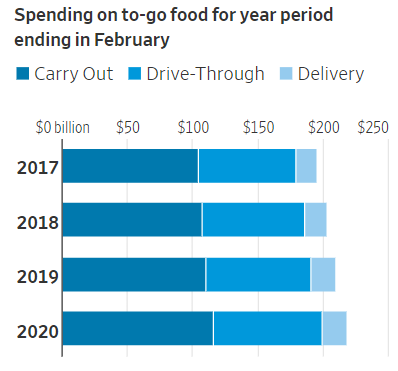There have not been many industries more severely impacted by the pandemic than the restaurant industry. Coming into 2020, the restaurant industry was projected to gross $899 billion. As of the first week of December 2020, the restaurant industry was estimated to have grossed only $659 billion. This $200 billion shortfall impacts small business owners, restaurant workers, industry partners and subcontractors, and even advertising partners.
As an experienced digital marketer responsible for national restaurant campaigns at Mindstream Media Group, I wanted to share my learnings from this experience in order to help any restaurant or marketer out there in some small capacity.
It may be obvious to point out, but the pandemic has seismically affected user behavior, both in real life and online. Under normal circumstances, 60 percent of dining is done off-site. During the pandemic, that figure has swelled to 90 percent.
This shift in consumer behavior increases the importance of placing a greater emphasis on carryout, catering and delivery. Unsurprisingly, restaurants with drive-throughs have generated a noticeably higher portion of visitors and sales than those without drive-throughs. 90 percent of Wendy’s 2020 sales is attributed to their drive-through business.

Source: Wall-Street Journal
Many restaurants were not preemptively equipped to handle this increase in carryout and drive-through business initially, so they got creative. Several restaurants we work with have added meal kits and unusual carryout items (like charcuterie boards) to their menus to help boost sales. Some restaurants are now selling wholesale ingredients to ensure their surplus inventory does not spoil. And I would say many of us are thankful that some restaurants now offer alcohol for carryout and delivery.
Adjust Keyword Targeting
With an additional 30 percent of diners choosing to eat at home, how does that affect their online behavior? Simply put, user search behavior has shifted to what is local, and what is available. Searches that include the words “available near me” have increased 100 percent globally year over year, and searches that include the words “restaurants open for” have increased 1,000 percent year over year.

Based on these statistics, one of the most important changes we’ve implemented in our client campaigns is to make sure keyword targeting reflects these consumer behavior changes, both for SEO and SEM. Some examples of these keywords include: “local restaurants open for delivery,” “restaurants open near me” and “nearest restaurant open.”
It is important to also keep in mind that other restaurants have taken this into consideration as well, which has led to a noticeable increase in SEM cost per click due to the increased competition among these keywords. In order to mitigate these cost increases, smart digital marketers are now looking for opportunities to add both exact match and longtail keywords and putting less emphasis on phrase match keywords. Another best practice is identifying variations of these more popular searches that are less competitive, by adding in the specific city or street name into campaign keywords.
Google Ads’ Keyword Planner can be used for ideas and estimates of keyword costs, as well as perform frequent search query reports within search campaigns to see which search terms are performing well, and which aren’t. If certain keywords aren’t performing well over a long period of time, the decision can be made to pause them, or look for opportunities to add negative keywords to the campaign.
Google keyword research also shows an uptick in search behavior that includes the words “safe” and “safety,” so those keywords are worth exploring as well. With that being said, I would encourage marketers to watch the performance of any ad text or messaging that focuses on “safety” closely. At the beginning of the pandemic, safety messaging performed extremely well. However, as the pandemic has continued, we are seeing across multiple campaigns that consumers have become less and less responsive to safety messaging, and more responsive to general brand messaging and Limited Time Offers.
Leverage Google Offerings
In addition to adjusting your SEM and SEO, it’s also critical that each Business Profile of all Google My Business restaurant locations are kept up to date. Make sure to update any changes to business information due to the pandemic, including hours of operation, menu limitations and safety measures you have taken. Users can reserve tables and order online through your business profiles, so this is just another avenue that can be can utilized to generate business and keep customers informed.

Another option Google offers small businesses that has helped greatly with the onset of the pandemic are Google Local Campaigns. Local Campaigns run dynamic creative across 4 different Google platforms: Google Search, YouTube, the Google Display Network and Google Maps to local customers in a business location’s service area. The campaign optimizes in real-time, mixing and matching the different headlines, descriptions, images and logos uploaded to the campaign, and automatically shows the best performing combinations. These algorithms utilize 7 million data points in a split second, determining when, where and to whom to show your ads, based on performance.
There is a caveat for running Local Campaigns: Google does recommend that a business run Local Campaigns with a Store Visit-focused strategy in an account that has at least 10 different restaurant locations, so this option lends itself more toward medium and large sized businesses. However, there is a separate bidding strategy for smaller businesses to run Local Campaigns: optimize towards phone calls and/or Google Maps driving direction clicks. So, while the primary option of Local Campaigns is to drive as much foot traffic as possible, Local Campaigns can use the same algorithmic data points to optimize towards driving customers to call and/or search for directions to your restaurant. Even during a pandemic, Local Campaigns remain one of the best digital marketing tactics a restaurant business can leverage – whether big or small.
Overall, marketing budgets are going to be much tighter in 2021 than they would be under normal circumstances, and marketers may not be able to execute all the digital marketing tactics they would otherwise. Being flexible and staying up to date with Google’s offerings and best practices can help businesses succeed and thrive in a changing environment.
Stay Creative
Saying that 2020 has been an unpredictable year would be an insulting understatement. It is difficult to tell if consumer behavior will return to normalcy in the long-term, or if this will drastically affect customer behavior permanently going forward. Regardless of that answer, it is important for all of us to remain creative and ensure that we’re not stagnant in our strategies. If I have learned anything from both digital marketing and 2020, it is that flexibility is imperative.
–Brian Pappas is a Sr. Digital Manager at Mindstream Media Group. An experienced digital marketer for over 7 years, Brian enjoys helping clients with their goals, voice acting and taking long walks on the beach.






















